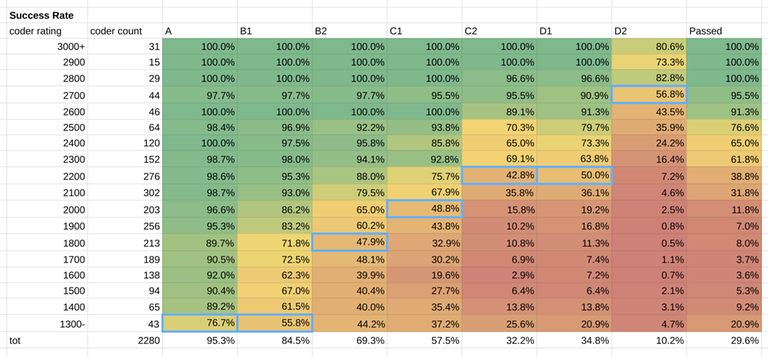td,dr: A 1000, B1 1200, B2 1800, C1 2000, C2 2300, D1 2200, D2 2600. You needed a slightly below 2300 rating to have a 50% prob of winning a t-shirt and advancing to round 3.
GCJ round 2 took place last weekend. Congratulation to everyone who won the t-shirt and advanced to round 3.
I provide below my estimate of the difficulty of the problems. This is a bit late, and I skipped round 1B and 1C, but I will do a summary of round 1 to catch up.
The data and methods are the same I described in my previous posts, see qualification round and round 1A.
Your feedback is very valuable to increase the quality of the estimates, and is very appreciated.
Method 1: The 50% Bucket
Approach and Data
Please see my previous post for an explanation.
Out of around 4'500 participants of GCJ 2, about 2'900 had a CF namesake.
I decided to exclude from the estimate about 30 participants with rating below 1000. If you made it this far, your skills are clearly above 1000 rating, so either you are smurfing, or I think you can expect your rating to sharply increase in the next few CF contests you participate in. Either case, your rating doesn't reflect your ability.
I also grouped the other participants below 1300 in a single bucket, since there aren't many left.

Results
This is the estimate: A 1300, B1 1300, B2 1800, C1 2000, C2 2200, D1 2200, D2 2700.
I think this approach gives reasonable results for most problems, with the exceptions of A and B1. Those two were easy for the majority of the contestants, so this method just place them at the lowest bucket available.
Method 2: Inverse Prob Function
Approach and Data
Again, please see my previous post for more details.
In this round, the average contestant rating was 2020. I tried to imply the difficulty of the problem given the success rate of the contestants close to the average ability ($$$2000 \pm 100$$$ rating), and the results... well, did not improve the estimate by much.
Results based on average contestant performance
A 1397, B1 1655, B2 1860, C1 1967, C2 2222, D1 2190, D2 2619.
As observed for previous rounds, the approach of inverting the prob function doesn't work well for problems very easy or very difficult for the contestant. For example, the difficulty of B1 is clearly inflated with this approach, and we weren't able to place A at a reasonable level below the 1300 bucket.
Results
This is the estimate: A1 1154, A2 1529, B1 1505, B2 1689, B3 2299, C1 1825, C2 1981, C3 2804.
The results are fairly in line with the previous method, which is a good sign. The two biggest differences are these:
A1 has a much higher rating now, around 1100. My impression is that the approach of inverting the prob function doesn't work very well for difficulties far away from contestants' rating. I do some average between the two estimate methods to adjust for it.
C2 difficulty dropped from 2300 to about 2000. Which one is more accurate? My personal impression is that 2300 is a bit too much, but I welcome your input here.
My Estimate
I put together the two estimates above, and I get this:
A1 800, A2 1500, B1 1500, B2 1700, B3 2000, C1 1900, C2 2100, C3 3000.
What rating did you need to be to pass the round? Well, 43% of coders rated 2000 qualified for Round 2. The percentage increases to 60% for 2100 rated participants. You needed to be about a Candidate Master to have a significant chance to pass. In the table above, right-most column, you can see more details.
What do you think?
Update based on feedback
- Lowered B3 from 2400 to 2000.






